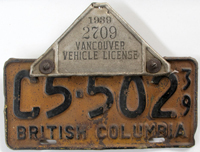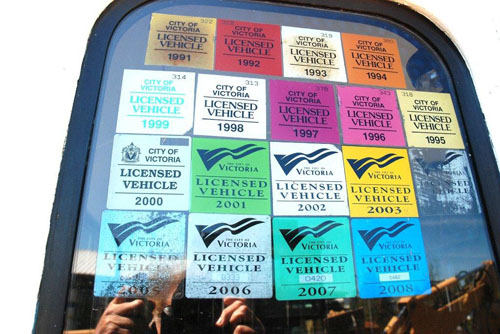|
British Columbia Municipal License Plates

The first provincial law concerning municipalities (i.e. An Act Respecting Municipalities) was passed in 1872, the year after British Columbia entered Confederation, and laid out basic criteria regarding the creation of city municipalities, the election of councils, and municipal taxation. |
A more extensive set of provincial laws - the Municipal Clauses Act - specifying areas of municipal responsibility would not be passed until 1896. Even then, it would not be until amendments to the Municipal Clauses Act in 1906 that municipalities would be granted the power to issue licences, and levy and collect fees for commercial vehicles. |
It is thought that the Vancouver Incorporation Act, had earlier empowered that municipality to regulate and license owners and drivers of stage coaches, livery, feed and sale stables and or horses, drays, express wagons, carts, cabs, carriages, omnibuses, etc ... |
|
The plate shown at left would have been issued to operators of drays or express wagons within the City of Vancouver. The date at right make the year of issue easy to determine. For those unfamiliar with what might constitute a "dray", it would have been a low heavy horse cart without sides that was used for haulage. It is assumed that a different classification of license would have possibly applied to motor vehicles. |
|
For other municipalities, the amended Act would allow them to collect such fees "from any person owning a pack train of six or more animals, freight wagon, stage coach, or omnibus used in transporting goods for profit or hire ..." |
In the context of automobiles, this would lead many municipalities to require a separate license plate for each community in which a vehicle was engaged in inter-municipal business. |
One of the first such plates came from the City of Victoria and, while it remains unclear as to whether their authority derived from their own Incorporation Act or the Municipal Clauses Act, their early issue porcelain license plates remain one of the more unique and rare of BC plate types. |
.jpg) |
Shown at left is an example of the porcelain licence plates issued by the City of Victoria in 1913 (and possibly again in 1914). |
| The No. 6 is probably one of the most (in)famous BC license plates ever issued as a result of decision by Guinness World Records to incorrectly (and regretably) declare it to be the "World's Oldest Licence Plate" for a brief period between September of 2010 and January of 2011. To read more about this incident, Click Here! |
|
*
* * * * |
 Allowing a municipality to license a vehicle was intended to
provide a source of revenue to participating municipalities to offset
expenses related to the use of local government roads and highways as a
result of commercial vehicle traffic. Expenses would include the cost of
maintenance of municipal roadways, road signage, snow removal,
parking control, etc ...
Interestingly, licensing was generally done on a semi-annual basis. Click on any one of the following plates to see a larger gallery of local government issued license plates: Allowing a municipality to license a vehicle was intended to
provide a source of revenue to participating municipalities to offset
expenses related to the use of local government roads and highways as a
result of commercial vehicle traffic. Expenses would include the cost of
maintenance of municipal roadways, road signage, snow removal,
parking control, etc ...
Interestingly, licensing was generally done on a semi-annual basis. Click on any one of the following plates to see a larger gallery of local government issued license plates: |
 |

Despite the introduction of the "Municipal Decals" in 1987, Section 668 of the Local Government Act still requires that a commercial vehicle must not be operated on a highway in a participating municipality unless the vehicle is displaying a valid licence plate (granted, the definition of a "licence plate" now includes a "licence decal"). |
Accordingly, there are still a few examples where an individual municipality will issue its own license plate. The City of Vancouver is probably the best example of this, where, under its Vehicle Licensing By-Law No. 4021, the following applies: |
The vehicle must display a permanently affixed BC Provincial “Municipal Decal” AND have either:
| |
a. |
Permanent business identification with business name and address on both sides of the vehicle. Business identification must be in letters and figures not less than 5 cm. high. |
| |
|
OR |
| |
b. |
A City of Vancouver “Commercial Permit Plate”. In this case no vehicle signage is required. |
|
|
The promoted benefits of displaying the decal or plate in Vancouver generally relate to loading privileges, such as stopping in a commercial load zone without cost, or being able to use a metered space without charge prior to 10:30am. |
Interestingly, the British Columbia Trucking Association (BCTA) opposes the municipal decal requirements and has advocated for its abolition on the basis that "the benefits once provided to commercial vehicles within a municipality (for example, commercial loading zones) have been greatly reduced or else are virtually non-existent." |
 |
As can been from the image at left, the City of Victoria also retains the ability to licence certain classes of vehicle. These particular decals were attached to a tourist bus operated by the Royal Blue Line. |
|
Sources
Statutes of British Columbia
Union of British Columbia Municipalities (UBCM) |

© Copyright Christopher John
Garrish. All rights reserved.
|